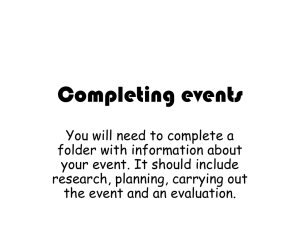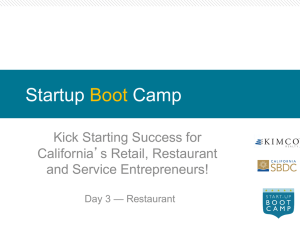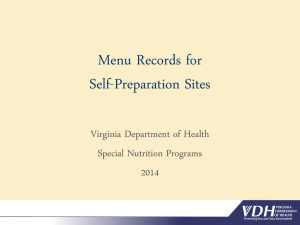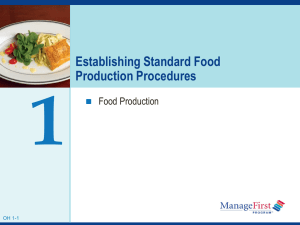menu and recipe
advertisement
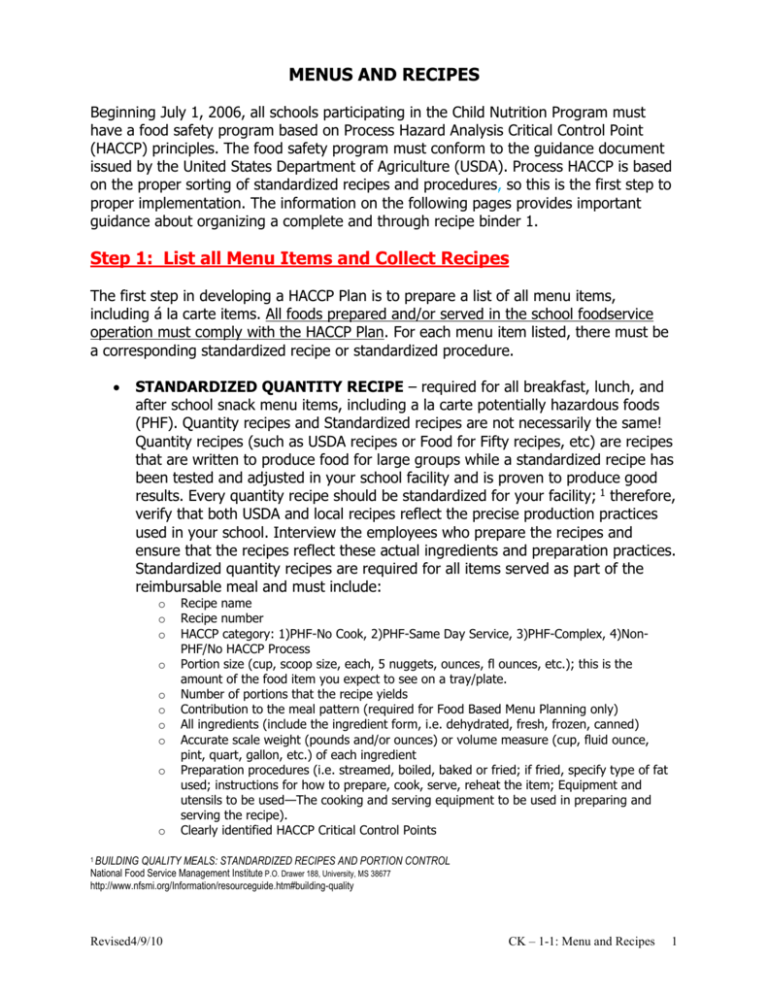
MENUS AND RECIPES Beginning July 1, 2006, all schools participating in the Child Nutrition Program must have a food safety program based on Process Hazard Analysis Critical Control Point (HACCP) principles. The food safety program must conform to the guidance document issued by the United States Department of Agriculture (USDA). Process HACCP is based on the proper sorting of standardized recipes and procedures, so this is the first step to proper implementation. The information on the following pages provides important guidance about organizing a complete and through recipe binder 1. Step 1: List all Menu Items and Collect Recipes The first step in developing a HACCP Plan is to prepare a list of all menu items, including á la carte items. All foods prepared and/or served in the school foodservice operation must comply with the HACCP Plan. For each menu item listed, there must be a corresponding standardized recipe or standardized procedure. STANDARDIZED QUANTITY RECIPE – required for all breakfast, lunch, and after school snack menu items, including a la carte potentially hazardous foods (PHF). Quantity recipes and Standardized recipes are not necessarily the same! Quantity recipes (such as USDA recipes or Food for Fifty recipes, etc) are recipes that are written to produce food for large groups while a standardized recipe has been tested and adjusted in your school facility and is proven to produce good results. Every quantity recipe should be standardized for your facility; 1 therefore, verify that both USDA and local recipes reflect the precise production practices used in your school. Interview the employees who prepare the recipes and ensure that the recipes reflect these actual ingredients and preparation practices. Standardized quantity recipes are required for all items served as part of the reimbursable meal and must include: o o o o o o o o o o 1 Recipe name Recipe number HACCP category: 1)PHF-No Cook, 2)PHF-Same Day Service, 3)PHF-Complex, 4)NonPHF/No HACCP Process Portion size (cup, scoop size, each, 5 nuggets, ounces, fl ounces, etc.); this is the amount of the food item you expect to see on a tray/plate. Number of portions that the recipe yields Contribution to the meal pattern (required for Food Based Menu Planning only) All ingredients (include the ingredient form, i.e. dehydrated, fresh, frozen, canned) Accurate scale weight (pounds and/or ounces) or volume measure (cup, fluid ounce, pint, quart, gallon, etc.) of each ingredient Preparation procedures (i.e. streamed, boiled, baked or fried; if fried, specify type of fat used; instructions for how to prepare, cook, serve, reheat the item; Equipment and utensils to be used—The cooking and serving equipment to be used in preparing and serving the recipe). Clearly identified HACCP Critical Control Points BUILDING QUALITY MEALS: STANDARDIZED RECIPES AND PORTION CONTROL National Food Service Management Institute P.O. Drawer 188, University, MS 38677 http://www.nfsmi.org/Information/resourceguide.htm#building-quality Revised4/9/10 CK – 1-1: Menu and Recipes 1 STANDARDIZED PROCEDURE – required for all ala carte menu items that include only one ingredient when standardized recipes are not developed. Standardized procedures can be used for a la carte menu items such as bottled beverages or commercially packaged non-PHF such as cookies, crackers, chips, etc. Procedures need to detail how the food is safely handled from the time it is removed from storage until the time it is placed onto the serving line. Include proper handling of leftovers and re-service of these type items. Step 2: Determine if the Menu Item is Potentially Hazardous or Non-potentially Hazardous After collecting all of the standardized recipes and procedures, determine if the recipes are potentially hazardous food or non-potentially hazardous and use this information for further recipe classification. Potentially hazardous foods support the rapid growth of harmful bacteria so they always require time-temperature control for safety (TCS). Potentially hazardous foods must be kept hot (135 degrees F or hotter) or cold (41degrees F or colder). Potentially hazardous food typically includes raw or cooked animal foods (meat, fish, poultry, dairy, eggs); heat-treated plant foods (cooked vegetables, baked potatoes, texturized vegetable protein); cut melon; sliced tomatoes; homemade garlic-in-oil; and raw bean sprouts. Non-Potentially Hazardous Foods (no HACCP Process Foods) do not support the rapid growth of harmful bacteria so they do not require time-temperature control for safety (TCS). These non-PHF foods may be served hot or cold. Below is relative information that may be helpful when classifying recipes. ANIMAL FOODS -- Raw meat, fish, poultry, and unpasteurized shell eggs must be cooked to proper endpoint cooking temperatures before serving. All commercially processed meat, fish, poultry, egg products, which are often labeled "Fully cooked") need to be cooked to 135oF or hotter before serving. Milk and milk products must be stored at 41oF or colder. FRUITS Most fruits are not potentially hazardous because of their low pH. Figs and melons only become potentially hazardous after they are cut or in the case of figs, when they are heated. Cut melons must be held at 41oF or colder for safety. If figs are cooked, they must be cooked to 135oF, held at 135oF, and if leftover, properly cooled, labeled, and used within three days. If not used within three days, they must be discarded. Non-potentially hazardous fruits do not need to be refrigerated for safety. They are refrigerated to extend their shelf life. However, some fresh fruits may have a water activity or acidity level that is inadequate to assure that a product assessment is not needed to show that they are safe. Therefore, as best practice, we recommend keeping all cut fruits at 41oF or colder to increase appeal, shelf life, and safety. Revised4/9/10 CK – 1-1: Menu and Recipes 2 (NOTE: Technically cooked fruits may contain adequate sugar and/or acidity to prevent harmful bacteria growth; however, it is difficult to determine the final water activity or pH level when various ingredients are added. It is unlikely that the SFA will provide for the laboratory analysis for a product assessment, therefore, we will assume that, in the absence of adequate information to prove otherwise, cooked fruits are to be held at a safe temperature or follow an approved TILT procedure as a precaution.) Canned fruit is generally NOT considered a potentially hazardous food because of its low pH and so does not require strict time and temperature for safety. The only exceptions would be if using canned figs. Figs are classified as low-acid foods and so must be maintained at 41 degrees F or colder for safety. It is also important to note that because canned fruit has been heat processed, there is a minimal food safety hazard unless contamination takes place after the can is opened. Contamination could result if bare hands come in contact with the exposed fruit, if somebody sneezes or coughs in it, or if dirty holding containers and utensils are used to display and dispense this product. Therefore, below are the procedures that should be followed to minimize contamination as well as to maintain quality. Most schools strive to keep canned fruits cold for quality. The unopened cans are put in the refrigerator the day before use. The can lid is wiped off before opening. The fruit is placed in a chilled pan that has been properly cleaned and sanitized. Pans of fruit are placed on the salad bar or serving line no more than one hour before service. If panned out before then, the product needs to be covered and refrigerated until it is placed on the serving line. Long-handled utensils that have been properly cleaned and sanitized are in each container of fruit. Leftover fruit that is on a self-service bar or serving line must be discarded. Leftover fruit that is on an employee-monitored serving line can be saved as a leftover but must be labeled, properly stored, and used within three days. VEGETABLES – Most vegetables are not potentially hazardous until they are heated and then hot-held (exceptions are cut tomatoes, lettuce, spinach, cabbage, salad greens, and sprouts which must be held at a safe temperature). In our schools, all cooked vegetables are potentially hazardous because they are heated and then placed on a hot serving line. All cooked vegetables must be heated to 135oF or hotter and held at 135oF or hotter. If leftover, they must be properly cooled, labeled, reheated, and served within three days. If not used within three days, they must be thrown out. Some fresh vegetables that are cut may have a pH and water activity level that is inadequate to ensure food safety. It is unlikely that SFAs will conduct product assessments to determine this information; therefore, as best practice, it is recommenced that all cut fresh vegetables be held at 41degrees F or colder or follow an approved TILT procedure. Revised4/9/10 CK – 1-1: Menu and Recipes 3 o Tomatoes. Cut tomatoes are considered potentially hazardous and will support the growth of Salmonella as demonstrated in recent outbreaks. Cut tomatoes are now classified as PHF and any recipe they are used in would be either No Cook-PHF or, if cooked, a PHF. Whole tomatoes do not need to be received or stored at refrigeration temperatures but once cut, they must be kept at 41oF or colder. Tomatoes that are cooked are potentially hazardous and so must be cooked to 135oF or hotter and held at 135oF or hotter. If tomatoes that come out of a can are cooked for hot holding, they must be cooked to 135oF or hotter. If tomatoes out of a can are not cooked and mixed with other non-potentially hazardous foods, then they are not potentially hazardous. o Lettuce, Spinach, Cabbage, and cut Salad Greens. Lettuce and all other cut salad greens such as spinach, cabbage, etc. are now classified as PHF and would be categorized as #1 No Cook – PHF. (Note: cutting includes a cut stem.) For packaged salad greens, if the bag states that the produce is washed and ready to use, no further washing is required. Cooked cabbage and spinach must be heated to 135oF or hotter and then held at 135oF or hotter; this recipe would be categorized as #2 Same Day Service. OTHER PLANT FOODS -- Any heat-treated plant food that has not been proven to be non-potentially hazardous must be classified as potentially hazardous. Examples include baked potatoes, sweet potatoes, cooked rice, cooked pasta, cooked pinto beans, other cooked beans, and texturized soy/vegetable protein. These foods must be cooked to 135oF or hotter and held at 135oF or hotter. If leftover, they must be properly cooled down, labeled, reheated, and served within three days. If not used within three days, they must be thrown out. o Peanut Butter. Peanut butter is not a potentially hazardous food because of its low water activity. Therefore, peanut butter and jelly sandwiches do not need to be refrigerated. o Garlic-in-oil. Most schools are not using garlic-in-oil as an ingredient. However, if you should use garlic-in-oil, use commercially processed product that lists acid as an ingredient. If made in-house, it must be refrigerated. o Raw bean sprouts. Only purchase bean sprouts from an approved supplier. When received, store at 41oF or colder. Revised4/9/10 CK – 1-1: Menu and Recipes 4 Step 3: Assign the Recipe/Procedure to a Process Category After determining if a menu item is potentially hazardous or not, make a determination about to which of the four process HACCP categories each recipe belongs (Each of the four categories is described below). After determining the HACCP process category for each recipe, indicate the name of category to which it was assigned on the recipe. Since the recipe includes this process category information, you may organize the recipes in a manner that best suits the district. Process Category 1: No Cook Process-PHF -- All menu items in this process category lack a cooking step thus the item does not go through the temperature danger zone (41oF to 135oF). Foods that are in this category include potentially hazardous foods that are received cold and served cold or potentially hazardous foods that are received hot and are served hot. Include appropriate Critical Control Points (CCP) on the recipe. Sample Flow Chart Receive Store Prepare Hold Serve Examples of Food Items Macaroni salad (commercially prepared) Milk Pumpkin pie (commercially prepared) Tuna salad prepared in-house Lasagna that is delivered hot from another school Sliced tomatoes Tossed Salads and Chef’s Salads Critical Control Points for No Cook Cooked and/or ready-to-eat foods stored above raw foods in the refrigerator. Foods are stored in this order: Prepared or ready-to-eat food (top shelf) Fish, seafood items, eggs Whole cuts of raw beef and pork Ground or processed meats Raw and ground poultry (bottom shelf) Hazard Cold holding at 41oF or colder or using time alone (less than four hours). Bacteria Hot holding at 135oF or hotter or using time alone (less than four hours). Bacteria Date marking ready-to-eat food that is prepared in the operation, refrigerating, and using within three days from the time of preparation. Bacteria, specifically Cooling potentially hazardous foods from room temperature to 41oF or colder within four hours. No bare-hand contact of any exposed cooked or ready-to-eat food. Spore-forming and toxin-forming bacteria Revised4/9/10 Bacteria Listeria monocytogenes Viruses and bacteria CK – 1-1: Menu and Recipes 5 Process Category 2: Same Day Service Process-PHF -- All menu items in this process category typically pass through the temperature danger zone (41oF to 135oF) only once before serving. Foods in this category include potentially hazardous foods that are cooked and held until served or that are cooked and served immediately. Sample Flow Chart Receive Store Prepare Cook Hold Serve Examples of Food Items Baked beans Bean burrito (prepared with commercially precooked ground beef or raw ground beef and served the same day) Chicken noodle bake (made with commercially precooked chicken or raw chicken prepared and served the same day) Orange glazed carrots Green Beans Rice Pizza Toasted cheese sandwich Critical Control Points for Same Day Service Hazard Cooking to recommended temperatures. Bacteria and parasites Hot-holding at 135oF or hotter or using time in lieu of temperature (TILT) Spore-forming bacteria No bare-hand contact of any exposed cooked or ready-to-eat food. Viruses and bacteria Revised4/9/10 CK – 1-1: Menu and Recipes 6 Process Category 3: Complex Food Preparation Process-PHF -- Menu items prepared in advance for next day service or items that are cooked, cooled, and served the same day are defined as a complex food preparation processes. These potentially hazardous foods pass through the temperature danger zone (41oF to 135oF) more than one time. Leftovers of any menu item that is typically prepared using same day service are not assigned to this category. Include appropriate CCPs on each recipe. Sample Flow Charts Receive Store Prepare Cook Cool Hold Serve Receive Store Prepare Cook Cool Reheat Hold Serve Examples of Food Items Turkey Roasts, cooked and cooled the day before service, then reheated for service. Bean burrito (made with ground beef cooked, cooled, and re-heated in the operation) Beef stew (made one or more days in advance, cooled, and then reheated) Egg salad sandwich (prepared fresh from raw eggs) Macaroni salad (prepared fresh in the operation) Critical Control Points for Complex Food Preparation Hazard Cooking to safe temperatures. Bacteria and parasites Cooling to 41oF within four to six hours. Spore-forming and toxinforming bacteria Hot holding at 135oF or hotter, cold holding at 41oF or colder, or using time alone (less than four hours). Bacteria and their toxins Date marking ready-to-eat food potentially hazardous food that is prepared in the operation, refrigerating, and using within three days from the time of preparation. No bare hand contact of any exposed cooked or ready-to-eat food. Revised4/9/10 Bacteria, specifically Listeria monocytogenes Viruses and bacteria CK – 1-1: Menu and Recipes 7 Process Category 4: Non-potentially hazardous foods – Menu items that do not meet the definition of a potentially hazardous food and so do not require time/temperature control for safety (TTS) are placed in this category. Non-PHF may be served hot or cold. Sample Flow Chart Receive Store Prepare Hold Serve Examples: Cookies Brownies Canned, frozen, and fresh fruit (cut or whole) Plain Biscuits, bagels, toast, English muffins Muffins Plain bread, rolls, and bun Peanut butter and jelly sandwich Commercially packaged snack foods (crackers, chips, cookies, etc.) Critical Control Point for Non-Potentially Hazardous Foods Hazard No bare-hand contact of any exposed cooked or ready-to-eat food. Viruses and bacteria Step 4. Identify foods that will be pre-prepared. Two common causes of food borne illness are: (1) preparing food too far in advance of service and (2) improperly cooling potentially hazardous foods. Some schools prepare foods in advance because it is economical. These foods are called pre-prepared foods. Many schools also save leftovers, that must be properly cooled and used within 3 days. There is a significant difference between pre-prepared foods and leftovers. All menu items can be leftovers but not all menu items are pre-prepared. Therefore, the first step is to identify which menu items you typically pre-prepare based on the following definitions of pre-prepared foods and leftover foods. Pre-Prepared Foods. Pre-prepared foods are menu items (or menu ingredients) that are prepared in advance for future service beyond a specific meal. These items are foods that are cooked or prepared in-house, properly chilled immediately after preparation, packaged, labeled, and then frozen for future use. Examples include browned ground beef, spaghetti sauce, chili, and breads. These pre-prepared items have a frozen shelf life of four weeks. This does not include commercially processed pre-prepared foods, such as Hot Pockets, Pizza, etc. For commercially processed frozen foods follow the manufacturer guidelines for storage time. Leftovers are menu items that are prepared for a specific day’s service and that are not served. Examples include a pan of soup that is in a hot box, a half empty pan of hog Revised4/9/10 CK – 1-1: Menu and Recipes 8 dog chili that is on the serving line, or six hamburgers that are on the serving line. These leftover menu items have a refrigerated or frozen shelf life of three days IF the final temperature of the item at the end of serving time is within the allowable “safe” temperature range. After pre-prepared foods are identified, note them on the PRE-PREPARED FOODS table found at the end of this section. Step 5: Note the Critical Control Points (CCP) on the Recipe. After assigning the standardized recipe/procedure to one of the four process categories, indicate the name of category to which it was assigned on the recipe and note the critical control point at the appropriate preparation step in the recipe. All critical control points must be properly identified on the recipe or procedure. For example, if cooking ground beef for lasagna, write “CCP: Cook to 155oF or higher for 15 seconds” so that it stands out as a critical control point on the recipe/procedure. All critical control point(s) listed on a recipe must be italicized, boldfaced, or underlined. NOTE: All current USDA standardized recipes have critical control points included in the preparation steps. However, many schools modify these recipes. If the recipe is modified in any way during preparation, holding or service, the modifications must be included on the recipe. Step 6: List Foods that use TILT Procedures. TILT foods are menu items using time without temperature control as the public health control for a working supply of potentially hazardous food before cooking, or for readyto-eat potentially hazardous food that is displayed or held for sale or service. All menu items subject to TILT must receive environmental health department approval prior to implementation of that procedure. Include copies of all approved TILT procedures at the designated place of the recipe binder. Step 7: Summarize the sorted menu items using the MENU SUMMARY table. Complete the MENU SUMMARY table found at the end of this section. This table must be reviewed before the beginning of each school year to be certain that it is current. Include only recipes in use by your schools. Any menu changes made from the previous year must be included. After it is complete, file in Binder 1. NOTE: Your nutrient analysis software may generate the HACCP menu summary; this listing is acceptable to replace the menu summary tables on pages 11-14. Refer to the software user’s guide for additional information. Revised4/9/10 CK – 1-1: Menu and Recipes 9 Step 8: Organize the menu summaries, listings, and recipes in the Binder 1. Organize Binder 1 as follows: 1. Binder Description (found in this section on page 10). 2. Menu Summaries for each of the HACCP processes – no cook, same day service, complex, and non-PHF/no HACCP process. 3. Listing of pre-prepared foods, if applicable. 4. Listing of TILT procedures. 5. Copies of all recipes/procedures organized as described on the Binder Description page. The Child Nutrition Administrator should decide on the district’s method of organization. It is recommended, but not required, that all schools within the same district organize binders in the same way so that employees (regular and substitute) will readily know how to locate the recipes. This practice will also allow child nutrition administrators, supervisors, training managers, consultants, and others to easily locate information at each school within the district. However, the Child Nutrition Administrator should determine an organization style that is best for the schools in the district. If the CN Administrator determines that individual schools may organize differently, the binder description at each school must match the organization at that school. Revised4/9/10 CK – 1-1: Menu and Recipes 10 Binder Description Describe below how recipes in this binder are organized. (i.e. by HACCP Process, by recipe number, alphabetic order by recipe name, by menu group categories, etc.) If organized other than by recipe number, alphabetically, or by HACCP process, include specific information below that will allow others to easily locate recipes in the binder. Check the appropriate box to describe how the recipes are organized in the binder: □ By 4 HACCP Process Categories □ By Recipe Number □ Alphabetically by Recipe Name □ By Recipe Category; list the name of each category below: 1. 2. 3. 4. 5. 6. 7. 8. 9. 10. □ Other: Please describe … NOTE: The Child Nutrition Administrator should decide on the district’s method of organization. It is recommended, but not required, that all schools within the same district organize binders in the same way so that employees (regular and substitute) will readily know how to locate the recipes. This practice will also allow child nutrition administrators, supervisors, training managers, consultants, and others to easily locate information at each school within the district. However, the Child Nutrition Administrator should determine an organization style that is best for the schools in the district. If the CN Administrator determines that individual schools may organize differently, the binder description at each school must match the organization at that school. Revised4/9/10 CK – 1-1: Menu and Recipes 11 MENU SUMMARY (Remember: Your nutrient analysis software may generate the HACCP menu summary; this listing is acceptable to replace the menu summary tables.) 1. No Cook Process-PHF – All potentially hazardous foods (PHF) or time/temperature control for safety (TCS) foods in this process category lack a cooking step thus there are no complete trips through the temperature danger zone (41oF to 135oF). (NOTE: If needed, this table can be extended by placing the curser in the last cell of the table and pressing the “tab” key.) Recipe/Procedure Name Revised4/9/10 Recipe # Date Reviewed CK – 1-1: Menu and Recipes 12 MENU SUMMARY 2. Same Day Service Process-PHF -- All potentially hazardous foods (PHF) or time/temperature control for safety (TCS) foods in this process category pass through the temperature danger zone (41oF to 135oF) only once before serving. Food is usually cooked and held until serving but can also be cooked and served immediately. (NOTE: If needed, this table can be extended by placing the curser in the last cell of the table and pressing the “tab” key.) Recipe/Procedure Name Revised4/9/10 Recipe # Date Reviewed CK – 1-1: Menu and Recipes 13 MENU SUMMARY 3. Complex Food Process -- Foods prepared in advance for next day service or foods that are cooked, cooled, and served the same day are defined as a complex food preparation process. All potentially hazardous foods (PHF) or time/temperature control for safety (TCS) foods in this process category pass through the temperature danger zone (41oF to 135oF) more than one time. (NOTE: If needed, this table can be extended by placing the curser in the last cell of the table and pressing the “tab” key.) Recipe/Procedure Name Revised4/9/10 Recipe # Date Reviewed CK – 1-1: Menu and Recipes 14 MENU SUMMARY 4. Non-potentially hazardous – These foods do not require time-temperature control for safety (TCS) and may be served at any temperature suitable to enhance appeal of the menu item. (NOTE: If needed, this table can be extended by placing the curser in the last cell of the table and pressing the “tab” key.) Recipe/Procedure Name Revised4/9/10 Recipe # Date Reviewed CK – 1-1: Menu and Recipes 15 PRE-PREPARED FOODS Signature of Responsible Person ____________________________________ Date completed ___________________________________________________ Pre-prepared foods are menu items (or menu ingredients) that are prepared in advance for future service beyond a specific meal. These items are foods that are cooked or prepared inhouse and then frozen for future use. Examples include browned ground beef, spaghetti sauce, chili, and breads. These items have a frozen shelf life of four weeks. Pre-prepared foods are NOT the same as leftovers. Leftovers are menu items that are prepared for a specific day’s service and that are not served. Only the items on this list can be frozen for up to four weeks. For all items on the list, procedures for packaging, labeling, and storing MUST also be clearly described on the standardized recipe/procedure. Pre-prepared foods must be properly cooled and stored in shallow containers so the item will freeze quickly. The container must be covered with a lid or freezer wrap that is appropriate for frozen storage. All pre-prepared foods must be labeled as Pre-prepared NAME OF FOOD with the DATE and TIME the item was prepared. This must be written directly on the freezer wrap or on freezer tape/label that is secured to the lid or wrap using a black permanent marker. If a menu item is not on this list and/or the handling procedures are not on the recipe, then the item must be handled as a leftover and so used within three days. Furthermore, once an item that is on the list is prepared for service, any remaining portions must be handled as a leftover. Recipe Name for Pre-prepared Foods Revised4/9/10 Recipe # CK – 1-1: Menu and Recipes 16 Time in Lieu of Temperature (TILT) FOODS TILT foods are menu items using time without temperature control as the public health control for a working supply of POTENTIALLY HAZARDOUS FOOD before cooking, or for READY-TO-EAT POTENTIALLY HAZARDOUS FOOD that is displayed or held for sale or service. All menu items subject to TILT must receive environmental health department approval prior to implementation of that procedure. Forms may be downloaded from http://www.deh.enr.state.nc.us/ehs/forms.htm or by requesting them from: Division of Environmental Health 1632 Mail Service Center Raleigh, NC. 27699-1632 (Courier 52-01-00) Place copies of all approved TILT procedures behind this page. Revised4/9/10 CK – 1-1: Menu and Recipes 17 Place a copy of the menu(s) served in the school behind this page. Include Breakfast, Lunch, Ala Carte, and After School Snack as applicable. Revised4/9/10 CK – 1-1: Menu and Recipes 18 Organize all recipes/procedures (breakfast, lunch, snack, a la carte) in the manner described on the Binder Description (page 10) behind this page. Revised4/9/10 CK – 1-1: Menu and Recipes 19
